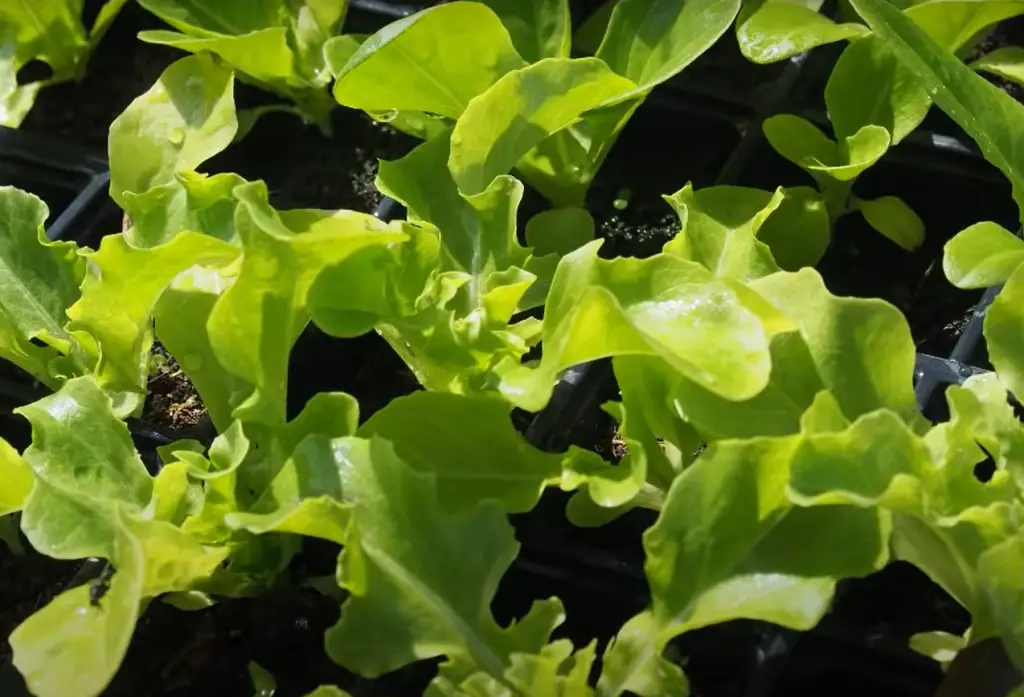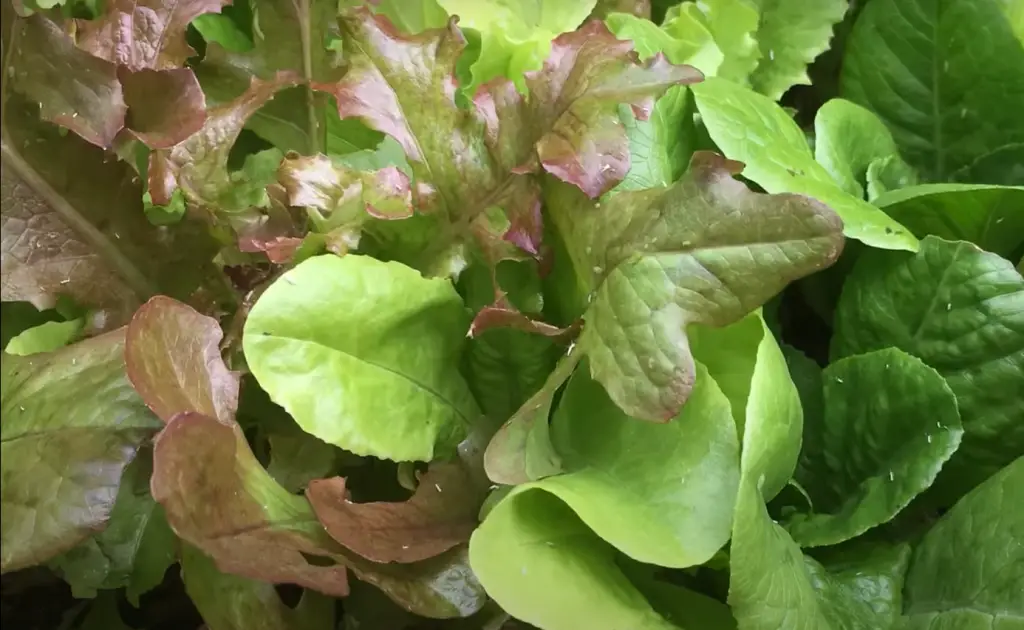Growing lettuce plants can be highly rewarding – they produce a readily-available food source that you can enjoy in salads, wraps, and sandwiches. But if your garden is plagued with pesky aphids, it may seem like there’s no way to protect the plants from their damage. Don’t give up hope just yet! In this blog post, we’ll discuss what you need to know about controlling aphids on lettuce and the best remedies for keeping them at bay so you can maximize yields of healthy greens all season long.
How to Grow Lettuce Plants?
Growing lettuce plants is a great way to add fresh salad greens to your diet. Lettuce is easy to grow and can be grown outdoors in the garden or indoors in containers.

Here are some tips for growing delicious lettuce:
- Choose the right variety of lettuce for your climate and season. There are many varieties of lettuces, so you’ll want to select one that works best in your area given the amount of sunlight, temperature, and soil conditions.
- Plant your lettuce seeds directly into moist, well-draining soil once the danger of frost has passed. Space the seeds about 1 inch apart, then cover with a thin layer of soil and water gently to keep them moist.
- Keep the soil evenly moist, but not soggy. Watering your lettuce too frequently will cause it to become waterlogged and rot.
- Feed your lettuce with a liquid fertilizer every 2-3 weeks for extra nutrition and growth. [1]
- Thin out the weakest seedlings so that there is space between each plant for adequate air circulation and sun exposure.
- Protect plants from extreme hot or cold temperatures with row covers or shade cloths if necessary.
- Harvest lettuce when leaves are crisp and succulent, usually within 40-60 days of planting depending on variety, season, and climate conditions. [2]
10 Tips for Caring for Lettuce Plants
- Provide adequate sunlight: Lettuce needs at least six hours of direct sun per day. If you live in an area with intense summer heat, provide some shade for your lettuce plants during the hottest part of the day.
- Water frequently: Lettuce requires regular watering to remain healthy and productive. Make sure to water your plants deeply and evenly, ensuring that the soil remains moist throughout the growing season. During periods of extreme heat or drought, increase the frequency of watering to keep the soil from drying out too quickly.
- Fertilize regularly: Feed your lettuce with a balanced fertilizer twice during its growing period for optimal growth and nutrition. A slow-release variety is ideal as it will provide nutrients over an extended period of time.
- Thin out your plants: If your lettuce patch becomes overcrowded, thin the seedlings to encourage air circulation and proper root development. This will help prevent disease and ensure that each plant has enough space to grow properly.
- Control weeds: Weeds can quickly choke out your lettuce plants if they are not kept in check. Remove any weeds that sprout up around the base of your lettuce plants so they can receive adequate sunlight, water and nutrition.
- Harvest carefully: Always use sharp scissors or a knife to cut lettuce leaves from the base of the stem just above where it meets the soil line. Leave a few inches of stem on each leaf so it can continue to grow and produce more lettuce.
- Store properly: If you plan on storing lettuce for a long period of time, wrap the leaves in a damp paper towel or place them in an air-tight container and store in your refrigerator. This will help keep the lettuce from drying out and wilting too quickly.
- Rotate crops: Planting different types of lettuce in different areas each year helps prevent diseases that are specific to certain varieties. This also prevents nutrient depletion from the soil as different types of plants require different amounts of nutrients to thrive.
- Prevent disease: To avoid any fungal or bacterial problems, make sure you water your plants at ground level rather than from above, use mulch around the base of your plants and rotate crops every year.
- Enjoy: After all that preparation, make sure to enjoy the fruits of your labor! Lettuce is a great addition to salads, sandwiches or any other dish you’d like to add a bit of color and flavor too! Have fun in the garden and don’t forget to share with friends and family. [3]
What Diseases are on Lettuce Plants?
Fusarium Wilt
A fungal disease that is caused by the Fusarium oxysporum fungus, which causes wilting and yellowing of lettuce plants.
Downy Mildew
This fungal disease is caused by the Peronospora parasitica and can cause dark spots on the leaves.
Bacterial Leaf Spot
Bacterial leaf spot is caused by Xanthomonas campestris and leads to pale yellow spots on the leaves as well as black deposits along the veins.
Alternaria Leaf Blight
This fungal disease is caused by Alternaria solani and it causes irregular dark green or gray spots on the leaves of lettuce plants.
Aphids
These tiny insects feed on the plants’ sap and can cause stunted growth, wilting leaves and yellowing of lettuce plants.
Cercospora Leaf Spot
This fungal disease is caused by Cercospora apii and causes small circular spots with a dark brown center surrounded by a pale halo on the lettuce leaves.
Lettuce Mosaic Virus (LMV)
LMV is transmitted through aphids or other vectors and can result in yellow mottling of lettuce leaves along with leaf deformation.
Powdery Mildew
This fungal disease is caused by Oidium neolycopersici and it results in white powdery spots on the underside of leaves.
Rhizoctonia Blight
This fungal disease is caused by Rhizoctonia solani and it results in reddish-brown lesions on the leaves as well as yellowing and wilting.
Pythium Root Rot
Caused by Pythium species, this disease can lead to yellowing of the lettuce leaves, stunted growth and wilting. It also affects the roots of the plant. [4]
How to Get Rid of Lettuce Plants Diseases?
One of the main problems that can affect lettuce plants is disease.

Diseases such as downy mildew, bacterial leaf spot, and Alternaria leaf blight can have devastating effects on an entire crop. To help prevent this from happening, there are some steps you can take to reduce the risk of diseases affecting your lettuce plants.
- Crop rotation: Rotating crops in a specific area every year will help keep diseases from spreading easily between different types of vegetables in the same family. For example, if you plant lettuce one year, try planting something else like tomatoes or peppers in that same spot next year so that different nutrients are being used by each type of vegetable.
- Removing infected leaves: If your lettuce plants start showing signs of disease, it’s important to remove any infected leaves as soon as possible. This will help stop the spread of the disease before it gets worse and can affect your entire crop.
- Proper water and fertilizer: Over-watering or over-fertilizing lettuce plants can make them more susceptible to diseases so it’s important to give them only enough water and fertilizer they need. Try using compost or other natural fertilizers instead of chemical ones, which can be too strong for delicate lettuce plants.
- Mulching: Mulching around your lettuce plants is a great way to keep weeds down while also helping reduce moisture loss and keeping soil temperatures even. This will create a healthier growing environment that helps reduce the risk of disease.
- Using fungicides: If all else fails, there are certain fungicides that can be used to help control diseases on lettuce plants. Before applying any chemical treatments, however, it’s important to research which type is best for your particular situation and follow all safety instructions. [5]
What Is Aphid?
Aphids are small, soft-bodied insects of the family Aphididae. They can be found on a variety of plants, and they feed by sucking sap from plant tissue. They reproduce rapidly and in large numbers and are often considered pests because of their ability to damage crops. Different species of aphids can cause different types of plant damage, including wilting, stunting, leaf yellowing, or curling. Some species even produce honeydew—a sweet secretion which can lead to sooty mold growth on the host plant. There are numerous strategies for controlling aphid populations and preventing crop losses, such as using natural predators like lady beetle larvae and lacewings or applying insecticides when necessary. Understanding what aphids are and how to control them is essential for keeping your plants healthy. [6]

Aphids come in a range of colors including green, yellow, brown, black, or pink. They have long antennae and two tubes—known as cornicles—on the rear of their bodies that produce a defensive fluid when disturbed.
Some species are wingless while others have wings which they use to disperse during warm weather. In addition to feeding on sap from plant tissue, some aphid species also feed on fungi or pollen grains.In large numbers, aphids can quickly damage plants by sucking up too much sap and introducing viruses and bacteria to the tissue. If left unchecked, they can quickly spread to other plants in the area. It is important to monitor your plants regularly for signs of an aphid infestation so you can take steps to control their populations before it’s too late.
If you are concerned about an aphid infestation on your plants, there are a few solutions available that can help prevent plant damage and keep your crops healthy. For example, applying insecticides when necessary or encouraging natural predators like lady beetle larvae and lacewings to feed on the pests can help control their numbers. In addition, removing any infected leaves from your plants will also help reduce the population of aphids in the area. With careful monitoring and preventative measures, you can keep your plants healthy and free from aphid damage. [7]
What are the Causes of Aphids in the Garden?
Aphids are a common garden pest, especially during the spring and summer months. There are several factors that can contribute to an aphid infestation in the garden.
One of the most common causes of aphids is over-fertilizing plants. Excessive fertilizer opens up an ideal environment for aphid growth by providing them with plenty of nutrients and food. Additionally, not providing enough water or failing to remove weeds from around your plants can also increase your chances of getting an aphid problem in the garden.
Another cause of aphids is overcrowding in the garden. When plants are too close together there is less air circulation which creates a prime environment for pests like aphids to thrive in since they can get plenty of food and shade from the surrounding foliage.

Finally, certain plants in the garden can attract aphids. These include flowering plants such as zinnias, cosmos, marigolds, and geraniums.
By understanding the causes of aphids and taking preventative measures, you can protect your garden from an infestation and keep your plants healthy for years to come.
What Does Aphid Damage Look Like?
Aphid damage can be identified by wilting, yellowing or distorted foliage. Leaves and stems may also have a sticky substance on them, which is the honeydew produced by the insects.
Other signs of aphids include discolored spots and mottling on leaves, curling of new growth and stunted plant development. Aphids congregate in groups on the underside of leaves or in buds and may even cover entire shoots in some cases. In addition to physical damage, they can transmit diseases from one plant to another as they feed.
If an infestation is allowed to continue unchecked for too long, it could cause serious harm to your plants. Therefore, it’s important to take steps to control aphids if you notice them on your plants. [9]
10 Proven Tips to Get Rid of Aphids on Lettuce Plants
Use Insecticidal Soap
It is a safe and effective way to get rid of aphids on lettuce plants. Be sure to thoroughly cover the leaves and stems of the affected plants with the soap, as this will help to eliminate any eggs or larvae that may be present.
Introduce Natural Predators
If you have other beneficial insects in your garden, such as ladybugs or lacewings, these can be great natural predators of aphids. Encourage them by providing food sources like flowers nearby.
Remove Infested Leaves
Go through each plant carefully and remove any leaves that are heavily infested with aphids. These leaves should not be composted or put back in the garden, as they may reintroduce the pests.
Spray with Water
A simple way to reduce aphid populations is to spray plants with a strong jet of water.

This will dislodge them from their hiding places and help get rid of many of them all at once.
Use Neem Oil
Neem oil is an effective natural insecticide that can be used to get rid of aphids on lettuce plants. Make sure to follow the directions on the packaging when applying it.
Try Beneficial Nematodes
Beneficial nematodes are microscopic worms that feed on pest insects like aphids and can be a great solution for getting rid of them in your garden without using harsh chemicals.
Use Horticultural Oils
Horticultural oils, such as mineral oil or vegetable oil, can be used to smother aphids and other pests on lettuce plants. Make sure to cover the entire plant for maximum effectiveness.
Try Homemade Sprays
There are many homemade sprays that can help get rid of aphids on lettuce plants. A popular one is a mixture of water and dish soap that can be sprayed directly onto pest infestations.
Plant Companion Plants
Certain companion plants, like garlic, mint, or marigolds, can help repel aphids when grown near susceptible lettuce plants. This will provide an added line of defense against these pesky pests.
Utilize Natural Repellents
There are several natural repellants, such as garlic and chives, which can be planted around susceptible plants to help naturally deter aphids from infesting them. Try planting a few of these throughout your garden to keep the pests away. [10]
Can I Fertilize Lettuce Leaf?
You can fertilize lettuce leaf. The best fertilizer to use for lettuce is a balanced fertilizer with an equal ratio of nitrogen, phosphorus and potassium. An example would be a 10-10-10 or 5-5-5 fertilizer. It means that it contains 10% nitrogen, 10% phosphorus and 10% potassium. This type of fertilizer is best because it provides a balanced boost of nutrients which will help your lettuce grow healthy and strong.
If you are growing in containers, you may need to fertilize more often than if you are planting directly into the ground.
If possible, choose an organic fertilizer that is slow release so it will slowly supply nutrients over time instead of all at once. Fertilizing your lettuce every 2 to 3 weeks during the growing season should give your plants enough nutrients to thrive. Also consider adding compost to your soil prior to planting as this will provide additional nutrients and help your soil retain moisture better. Avoid using too much nitrogen or high amounts of water soluble fertilizers as these can cause “tip burn” on the leaves of your lettuce. Lastly, be sure to water the soil and not just the plants so that the fertilizer can get to the root system where it is needed. [11]
FAQs
What is a natural remedy for aphids on lettuce?
One of the most effective natural remedies is a mixture of water and liquid dish soap. Start by mixing 1 teaspoon of liquid dish soap with one quart (4 cups) of lukewarm water. Next, spray the mixture onto any affected areas of your lettuce plant. The soap will help break down the waxy outer coating of the aphids, which makes them more susceptible to predators like ladybugs. Additionally, you may want to introduce beneficial predatory insects such as lacewings or ladybugs that feed on aphids into your garden.
Can you eat lettuce that has had aphids on it?
If there are a few aphids present, you may be able to wash them off and still eat the lettuce safely. However, if the infestation is heavy or more widespread, it is best to discard the lettuce as consuming too many pest-infested vegetables can lead to foodborne illnesses. Additionally, some varieties of aphids can carry diseases that could make humans sick upon consumption.
How do I get rid of aphids permanently?
Aphids can be a nuisance to gardeners, but there are several ways to get rid of them permanently. The easiest and safest way is to use natural predators like ladybugs or parasitic wasps that feed on aphids. If you don’t have these available in your area, then you may need to resort to using chemical insecticides or organic solutions such as neem oil. It is an effective insecticide that won’t harm beneficial insects or the environment. To get the most out of it, spray it directly onto any plants affected by aphids.
How do you get rid of bugs in lettuce?
The best way to get rid of bugs in lettuce is to inspect the produce before purchasing it. Look for holes, nicks, and discoloration on the leaves that might indicate an infestation. If you find any signs of insects, do not purchase the lettuce. If you already have lettuce with bugs present, there are a few methods to try at home. Pick off any visible insects and discard them, soak the lettuce in cold water with a tablespoon of vinegar or lemon juice mixed in for 15-20 minutes. This method will kill both larvae and adult pests.
Useful Video: Aphids In Lettuce
Conclusion
It goes without saying that a successful aphid control requires consistent monitoring and implementation of the instructions specified in this article. Nevertheless, implementing these tips may help you to successfully cultivate safe and ecological products in the long-run. One major benefit of using eco-friendly techniques to manage pathology is that they don’t have adverse consequences on the environment or your harvest. With a good strategy, you can protect your plants without running negative risks connected with chemical insecticides. We hope this article has been empowering in helping you take control over aphids. All it takes is careful work and diligent research to make sure that your garden is pest-free and full of healthy produce!
References:
- https://www.rhs.org.uk/vegetables/lettuce/grow-your-own
- https://bonnieplants.com/blogs/how-to-grow/growing-lettuce
- https://www.hobbyfarms.com/10-tips-to-grow-great-lettuce/
- https://plantvillage.psu.edu/topics/lettuce/infos
- https://www.vegetables.bayer.com/nz/en-nz/resources/growing-tips/agronomic-spotlights/managing-lettuce-diseases.html
- https://hort.extension.wisc.edu/articles/aphids-2/
- https://www.britannica.com/animal/aphid
- https://gardening.yardener.com/Causes-For-Aphids
- https://www.lawnbuddies.com/blog/identify-get-rid-aphids-trees-shrubs
- https://www.almanac.com/pest/aphids
- https://www.latimes.com/archives/la-xpm-1986-11-29-vw-16039-story.html










Leave a Reply
View Comments